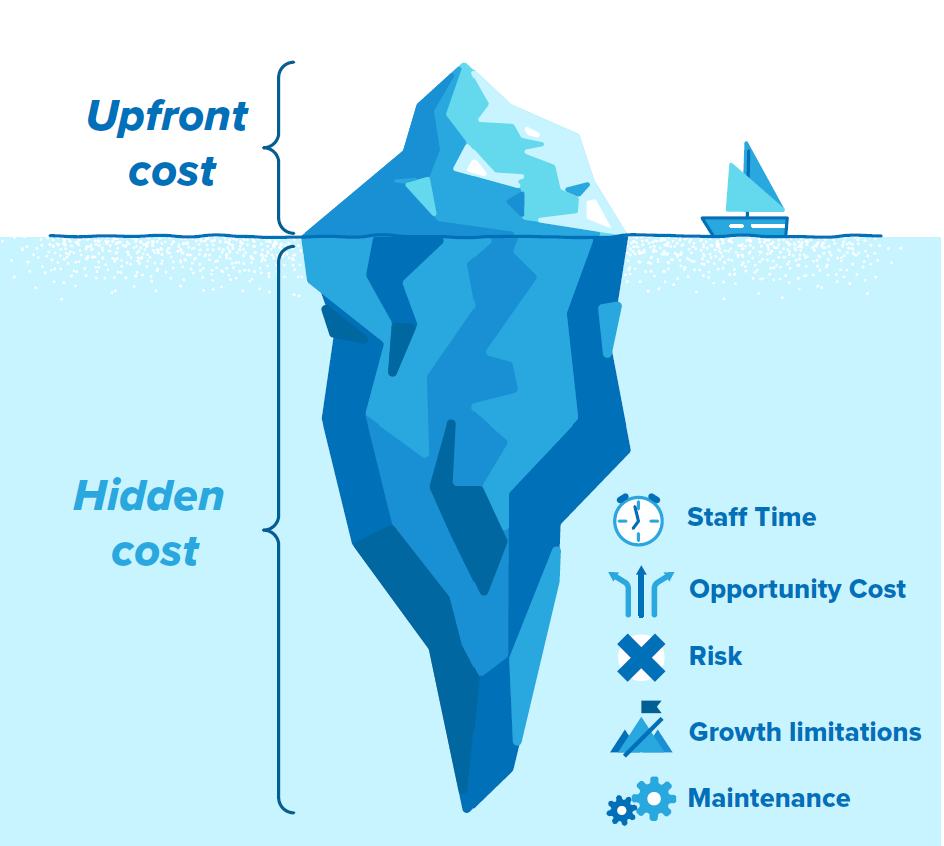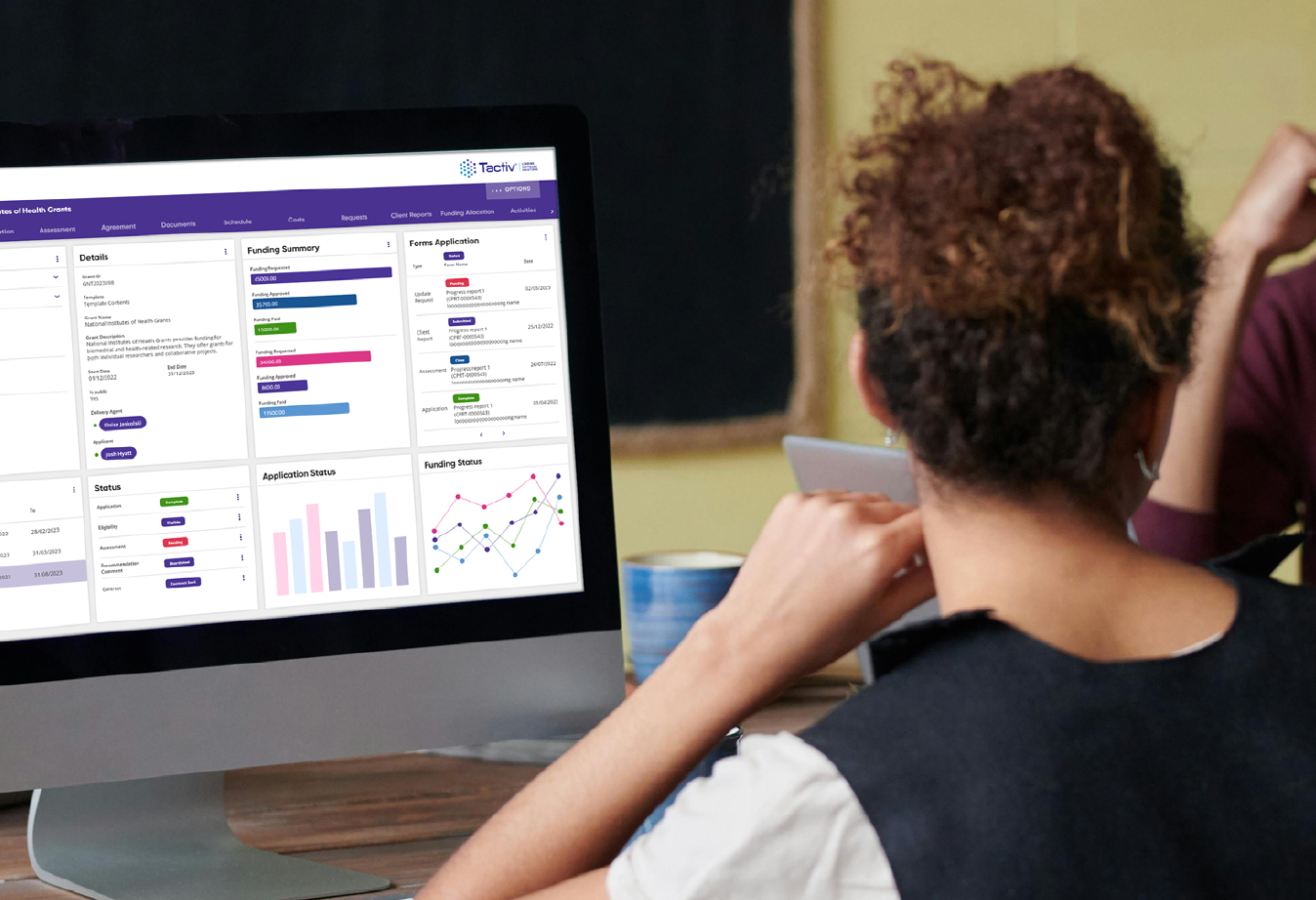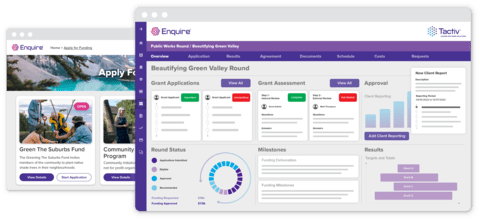The Definitive Guide to Scholarship Management Solutions: Key takeaways
- Building your own scholarship management solutions offer complete customisation but comes with significant hidden costs and burdens, including ongoing maintenance, expertise requirements, and potential scope creep.
- Buying specialised scholarship software provides immediate implementation, industry best practices, and dedicated support, allowing organisations to focus on their core mission rather than software development and maintenance.
- The true cost of “making do” with existing systems or building in-house is often underestimated, and a thorough cost comparison should consider staff time, opportunity cost, risk assessment, growth limitations, and maintenance realities.
The pros and cons of building scholarship software
So you’re thinking about building your own scholarship management solution. It’s tempting to believe your team knows your needs best and can create the perfect system tailored to your exact requirements. But before you greenlight that project, let’s look at what you’re really signing up for.
Pros of building your own scholarship management solution:
- Complete customisation – You get exactly what you want, designed around your specific workflows and processes.
- Total control over features – You decide what gets built, when it gets built, and how it functions.
- Integration with existing systems -Your in-house team can potentially create seamless connections with your current technology stack.
- No dependency on external vendors – You’re not at the mercy of another company’s product roadmap or pricing changes.
- Institutional knowledge retention – The development process helps your team better understand your scholarship workflows.
Cons of building your own scholarship management solution:
- Scope creep is inevitable – What starts as a simple project often expands as requirements evolve, leading to delays and complications.
- Maintenance becomes your burden – Every update, security patch, and bug fix falls on your team’s shoulders for the life of the system.
- Expertise requirements are steep – You’ll need specialised staff not just for building but for ongoing support, which means competing for tech talent.
- Opportunity cost is significant – Resources devoted to development mean less focus on your core mission of supporting scholars.
- Regulatory updates become your problem – When data privacy or accessibility laws change, it’s on you to ensure compliance.
When you build your own solution, you’re not just developing software—you’re committing to being a software company in more ways than you can imagine. Your team shifts from scholarship management experts to software maintainers.
While having complete control might seem advantageous now, it often becomes a burden that distracts from your primary mission, like finding and supporting exceptional scholars.

The pros and cons of buying scholarship management solutions
Purchasing specialised scholarship management software means entrusting a critical function to experts who focus exclusively on solving these problems. Let’s examine what this choice really means for your organisation.
Pros of buying a specialised scholarship management solution:
- Immediate implementation – Get up and running quickly with proven solutions rather than waiting months or years for development.
- Industry best practices built-in – Benefit from features developed based on experiences across many scholarship programs.
- Continuous improvement without your effort – Vendors regularly update features and security without taxing your resources
- Dedicated support and training – Access expertise and assistance designed specifically for scholarship management.
- Focus remains on your core mission – Your team can concentrate on scholar selection and support rather than software issues.
Cons of buying a specialised scholarship management solution:
- Less customisation – You may need to adapt some processes to fit the software rather than the other way around.
- Subscription commitment – You’ll have the ongoing subscription costs of the vendor rather than your own development expenses.
- Potential vendor dependency – You’re relying on the vendor’s stability and commitment to continued product support.
- Learning curve for new systems – Your team will need to adapt to new workflows and interfaces.
- Data migration challenges – Moving from current systems may require significant effort upfront.
When you buy specialised scholarship management software, you’re making a strategic decision to focus on your core competency: running exceptional scholarship programs.
You’re leveraging expertise from specialists who understand not just technology but the specific challenges of scholarship administration. This allows your team to evolve from spreadsheet managers to strategic program leaders who can demonstrate meaningful impact.
➔ Read more about the value of a specialised scholarship management tool here.
The true cost comparison: In-house vs. specialised scholarship management solutions
While we’ve examined the pros and cons of each approach, there’s an elephant in the room that often whispers rather than roars in these discussions: the true cost.
Companies naturally gravitate toward what seems like the more economical option upfront. “Why pay for new software when we could simply adapt what we already have?” It’s a tempting thought—until you peer beneath the surface.
The hidden reality of “making do”
It may seem like a logical solution to configure your existing software systems to work for you and maintain a small tech stack. But ask yourself: Why do these systems not work for you in the first place?
By configuring your existing systems, you could end up running scholarship programs in ways that don’t fit your actual processes but work well for your existing software. Is forcing your program into ill-fitting technology really a win? Is this sustainable as your program evolves?
Consider this scenario: Your team spends months configuring your current CRM to handle scholarship applications. Six months later, you want to add a mentoring component to your program, but your customised system can’t accommodate this new element. You’re now faced with either abandoning the initiative or starting another round of costly configuration.
Vanessa Crowther, Customer Success Manager at Tactiv
What’s the real price tag?
When calculating the cost of any solution, consider these often-overlooked factors:
- Staff time valuation: What is the hourly cost of your team members who will build, configure, or maintain in-house solutions?
- Opportunity cost: What strategic initiatives will you delay or abandon while focusing on software development?
- Risk assessment: What is the financial impact if development takes twice as long as expected? (Hint: It usually does)
- Growth limitations: How much will it cost to adapt your custom solution when your program expands or changes direction?
- Maintenance reality: Have you budgeted for ongoing updates, security patches, and technical debt management?
Calculate your true cost
To understand what your in-house solution might really cost, try this simple calculation:
- Estimated development hours × Average hourly rate of your IT staff = Initial development cost
- Monthly maintenance hours × Average hourly rate of your IT staff = Monthly maintenance cost
- Hours spent working around system limitations per month × Average hourly rate scholarship staff = Monthly inefficiency cost
- Add unexpected development costs (typically 50-100% of initial estimate)
The total gives you a clearer picture of what “building your own” actually means for your budget. Armed with this more realistic assessment, you can now approach the build-versus-buy decision with eyes wide open, ready to evaluate which option truly aligns with your scholarship program’s mission and future.
Making the right decision: A framework for evaluation
Now that you understand the pros, cons, and true costs of both approaches, how do you determine which path is right for your organisation? Let’s create a practical framework to guide your decision-making process.
Evaluation criteria checklist
Consider rating your organisation against these key criteria to clarify which solution aligns better with your needs. For each criterion, score both options from 1 (poor fit) to 5 (excellent fit).
Rating Scale: 1 = Strongly disagree, 2 = Disagree, 3 = Neither agree nor disagree, 4 = Agree, 5 = Strongly agree
| Criteria statements to consider | Statements to consider | In-house score (1-5) | Specialised software score (1-5) |
|---|---|---|---|
| Strategic alignment | This option aligns with our core mission and institutional strengths | ||
| Implementation timeline | This option allows me to work within the expected timeframe | ||
| Technical resources | I have the necessary expertise readily available | ||
| Risk management | This option minimises potential risks to my program | ||
| Future-proofing | This solution will adapt easily as my programme evolves | ||
| Compliance & security | This option simplifies maintaining regulatory compliance | ||
| Budget predictability | The costs associated with this option are predictable |
How to interpret your scores:
- Total each column to compare overall fit
- Pay special attention to any criteria you’ve identified as mission-critical
- Consider whether low scores in certain areas present acceptable risks for your organisation
Watch for warning signs that in-house development might not work: stretched IT teams, past project overruns, high staff turnover, and evolving requirements. Ask yourself: Where does your team create the most value? How will you handle staff departures? Who will maintain compliance with changing regulations? Most importantly, which approach better supports your scholarship program’s true impact?
This framework isn’t about finding a universal answer—it’s about identifying the solution that best fits your specific context. While building in-house might seem appealing initially, most institutions discover that specialised scholarship management solutions deliver greater long-term value without the hidden complexities and ongoing resource requirements of custom development.
By working through this evaluation process thoughtfully, you’ll gain clarity not just on your technology choice but on your scholarship program’s core needs and strategic direction.
Preparing for the future: Your next steps
Throughout this guide, we’ve explored the crucial build-versus-buy decision for scholarship management solutions. What’s becoming increasingly clear is that scholarship administration is evolving rapidly, with several trends shaping its future:
- Data-driven decision-making is becoming essential, with organisations seeking deeper insights into program impact and return on investment
- Scholar journey mapping now extends beyond graduation into alumni engagement and long-term outcome tracking
- Integrated ecosystems are replacing siloed approaches, with scholarship management connecting seamlessly to financial, academic, and engagement platforms
- Compliance requirements continue to grow more complex, demanding sophisticated security and privacy controls
Bottom line? Your technology choices today will determine how effectively you can adapt to these emerging trends.
Enquire as a scholarship management solution
Our scholarship management platform addresses end-to-end management of the entire scholar journey from application to alumni, powerful analytics dashboards that demonstrate program impact and outcomes, seamless integration with your existing financial and student information systems, regular updates that keep pace with evolving regulations and best practices, and configurable workflows that adapt to your unique program requirements.
BUSY at Work x Tactiv | A scholarship management case study
Busy At Work, for example, runs six different scholarship programs for state and federal government and has achieved remarkable operational efficiency by moving from spreadsheets to our platform. The change has enabled truly data-driven decision-making while ensuring scalability across their diverse programs.
The question isn’t whether you can afford specialised scholarship management solutions – it’s whether you can afford to continue without it. As scholarship programs become increasingly strategic initiatives rather than mere financial transactions, having the right technology foundation becomes mission-critical.
Move forward with the right scholarship management solution
Book a demo today to see how our platform can address your specific scholarship management challenges and position your program for future success. Alternatively, sign up for our newsletter to stay informed about emerging trends and best practices in scholarship administration.
Enter your email here for the latest on scholarship management, additional resources and industry news






